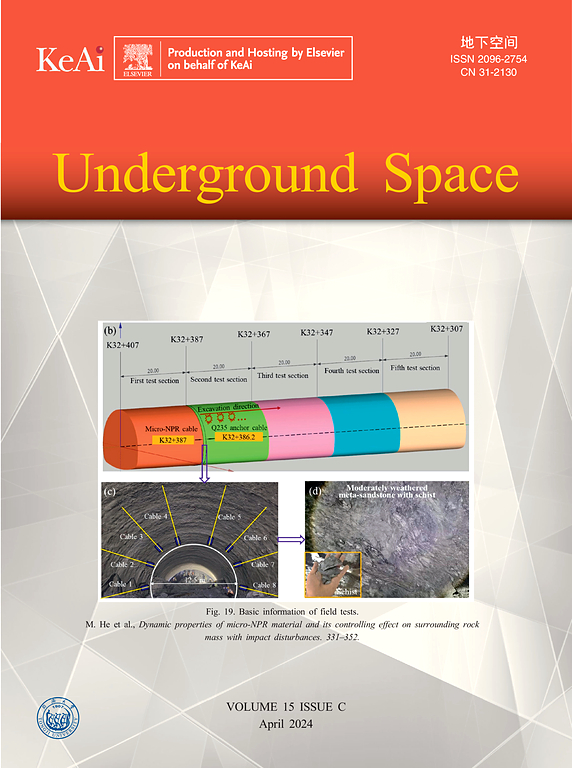A multi-scale coupled method for nonlinear dynamic response analysis of mountain tunnels subjected to fault movement
IF 8.3
1区 工程技术
Q1 ENGINEERING, CIVIL
引用次数: 0
Abstract
This paper introduces a novel two-step multi-scale coupled method for simulating the nonlinear dynamic behavior of a mountain tunnel subjected to fault movement. In the first step, the broadband seismic responses within a large-scale mountain-fault model can be accurately solved by the indirect boundary element method, converting them into effective input forces around the specified region of interest within the mountain. The second step involves finely simulating the nonlinear dynamic response of the tunnel cross-section in the designated region using the finite element method, with the implementation of a viscoelastic artificial boundary to absorb the reflection of scattered waves at truncated boundaries. Two verification processes are employed to validate the accuracy of the multi-scale coupled method. Furthermore, we illustrate the applicability and efficacy of the new method with an example involving the elastoplastic dynamic analysis of a mountain tunnel under the influence of normal fault movement. The presented example highlights the impact of fault motion parameters, including fault dislocation value and dip angle, on the responses of the mountain tunnel. The results demonstrate that the proposed multi-scale coupled method can achieve full-process seismic simulation, ranging from kilometer-scale fault rupture to centimeter-scale mountain tunnel section damage, with a considerably reduced computational expense.
断层运动作用下山地隧道非线性动力响应分析的多尺度耦合方法
本文介绍了一种新的两步多尺度耦合方法,用于模拟断层运动作用下山地隧道的非线性动力行为。第一步,采用间接边界元法精确求解大尺度山断层模型内的宽带地震响应,将其转化为山内指定感兴趣区域周围的有效输入力。第二步采用有限元方法精细模拟指定区域内隧道断面的非线性动力响应,采用粘弹性人工边界来吸收截断边界处散射波的反射。采用两个验证过程验证了多尺度耦合方法的准确性。最后,以某山地隧道正断层运动影响下的弹塑性动力分析为例,说明了该方法的适用性和有效性。该算例突出了断层位移值和断层倾角等断层运动参数对山间隧道响应的影响。结果表明,所提出的多尺度耦合方法可以实现从千米尺度断层破裂到厘米尺度山地隧道断面破坏的全过程地震模拟,且计算量大大降低。
本文章由计算机程序翻译,如有差异,请以英文原文为准。
求助全文
约1分钟内获得全文
求助全文
来源期刊

Underground Space
ENGINEERING, CIVIL-
CiteScore
10.20
自引率
14.10%
发文量
71
审稿时长
63 days
期刊介绍:
Underground Space is an open access international journal without article processing charges (APC) committed to serving as a scientific forum for researchers and practitioners in the field of underground engineering. The journal welcomes manuscripts that deal with original theories, methods, technologies, and important applications throughout the life-cycle of underground projects, including planning, design, operation and maintenance, disaster prevention, and demolition. The journal is particularly interested in manuscripts related to the latest development of smart underground engineering from the perspectives of resilience, resources saving, environmental friendliness, humanity, and artificial intelligence. The manuscripts are expected to have significant innovation and potential impact in the field of underground engineering, and should have clear association with or application in underground projects.
 求助内容:
求助内容: 应助结果提醒方式:
应助结果提醒方式:


